Rhythm Collections Business Plan for Small Business Ownership Course
VerifiedAdded on 2022/10/06
|10
|2293
|13
Project
AI Summary
This business plan, created by a student for their Small Business Ownership course, outlines the financial and operational strategies for a music instrument shop called Rhythm Collections. The plan details the owner's investment, borrowed money, and the initial cash and assets required. It includes a comprehensive sales and revenue analysis, a cash budget, and a projected income statement, along with ratio and trend analyses to assess profitability and financial health. The plan also covers operational aspects such as equipment, store layout, and logistics. The financial projections anticipate a steady increase in revenue and profitability over three years. The student analyzes gross margins and concludes with a positive outlook for the business's potential. The references used are also mentioned.
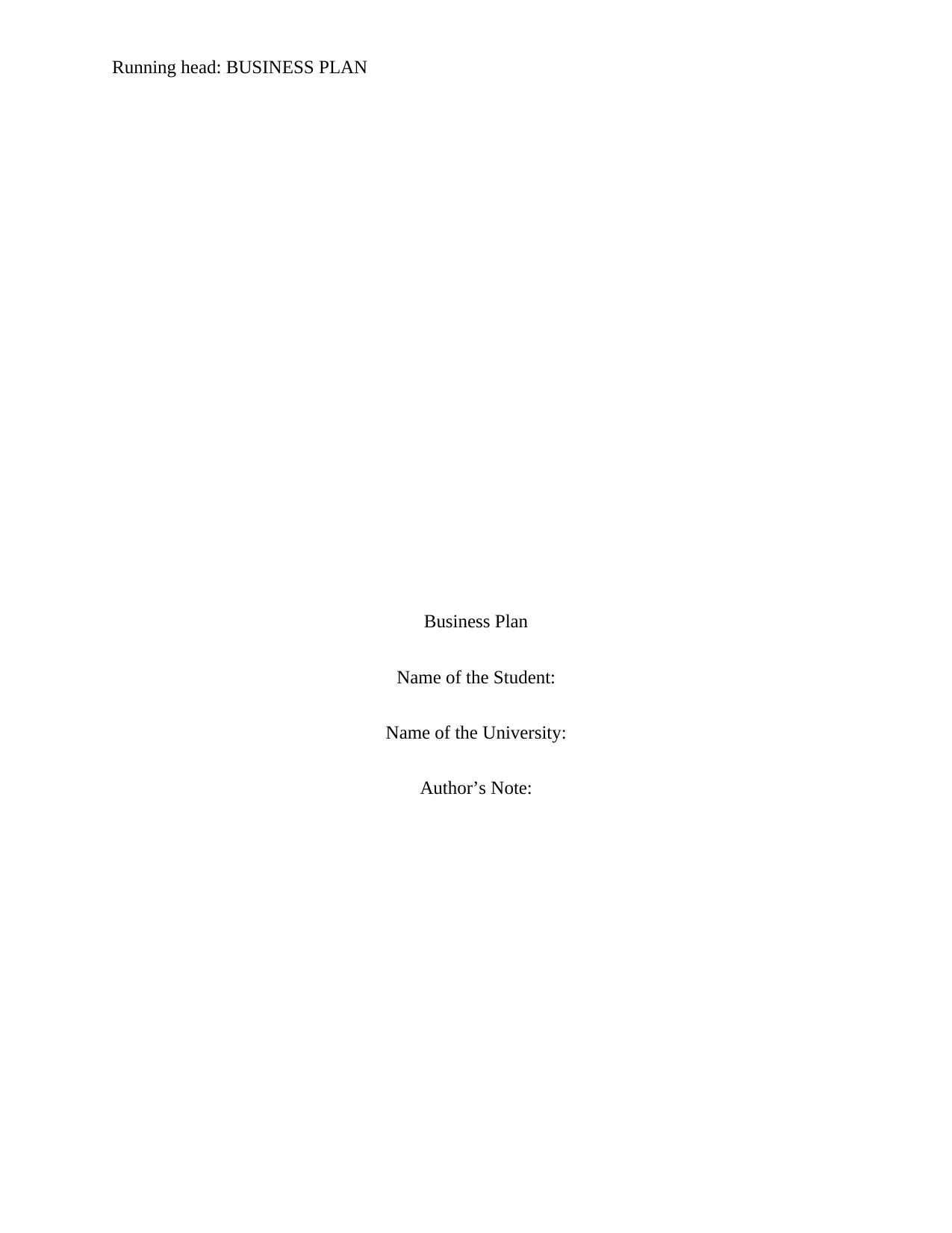
Running head: BUSINESS PLAN
Business Plan
Name of the Student:
Name of the University:
Author’s Note:
Business Plan
Name of the Student:
Name of the University:
Author’s Note:
Paraphrase This Document
Need a fresh take? Get an instant paraphrase of this document with our AI Paraphraser
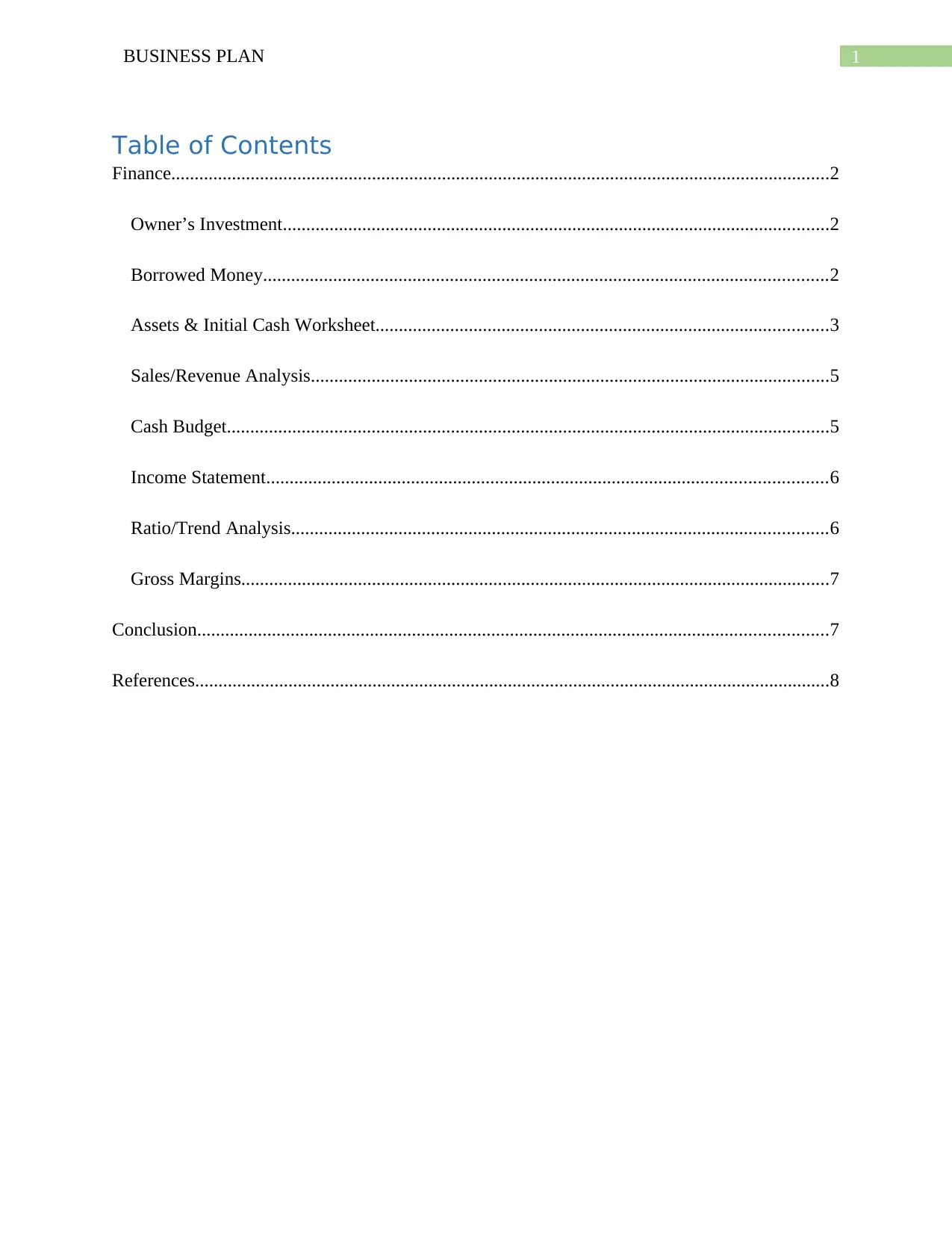
1BUSINESS PLAN
Table of Contents
Finance.............................................................................................................................................2
Owner’s Investment.....................................................................................................................2
Borrowed Money.........................................................................................................................2
Assets & Initial Cash Worksheet.................................................................................................3
Sales/Revenue Analysis...............................................................................................................5
Cash Budget.................................................................................................................................5
Income Statement........................................................................................................................6
Ratio/Trend Analysis...................................................................................................................6
Gross Margins..............................................................................................................................7
Conclusion.......................................................................................................................................7
References........................................................................................................................................8
Table of Contents
Finance.............................................................................................................................................2
Owner’s Investment.....................................................................................................................2
Borrowed Money.........................................................................................................................2
Assets & Initial Cash Worksheet.................................................................................................3
Sales/Revenue Analysis...............................................................................................................5
Cash Budget.................................................................................................................................5
Income Statement........................................................................................................................6
Ratio/Trend Analysis...................................................................................................................6
Gross Margins..............................................................................................................................7
Conclusion.......................................................................................................................................7
References........................................................................................................................................8
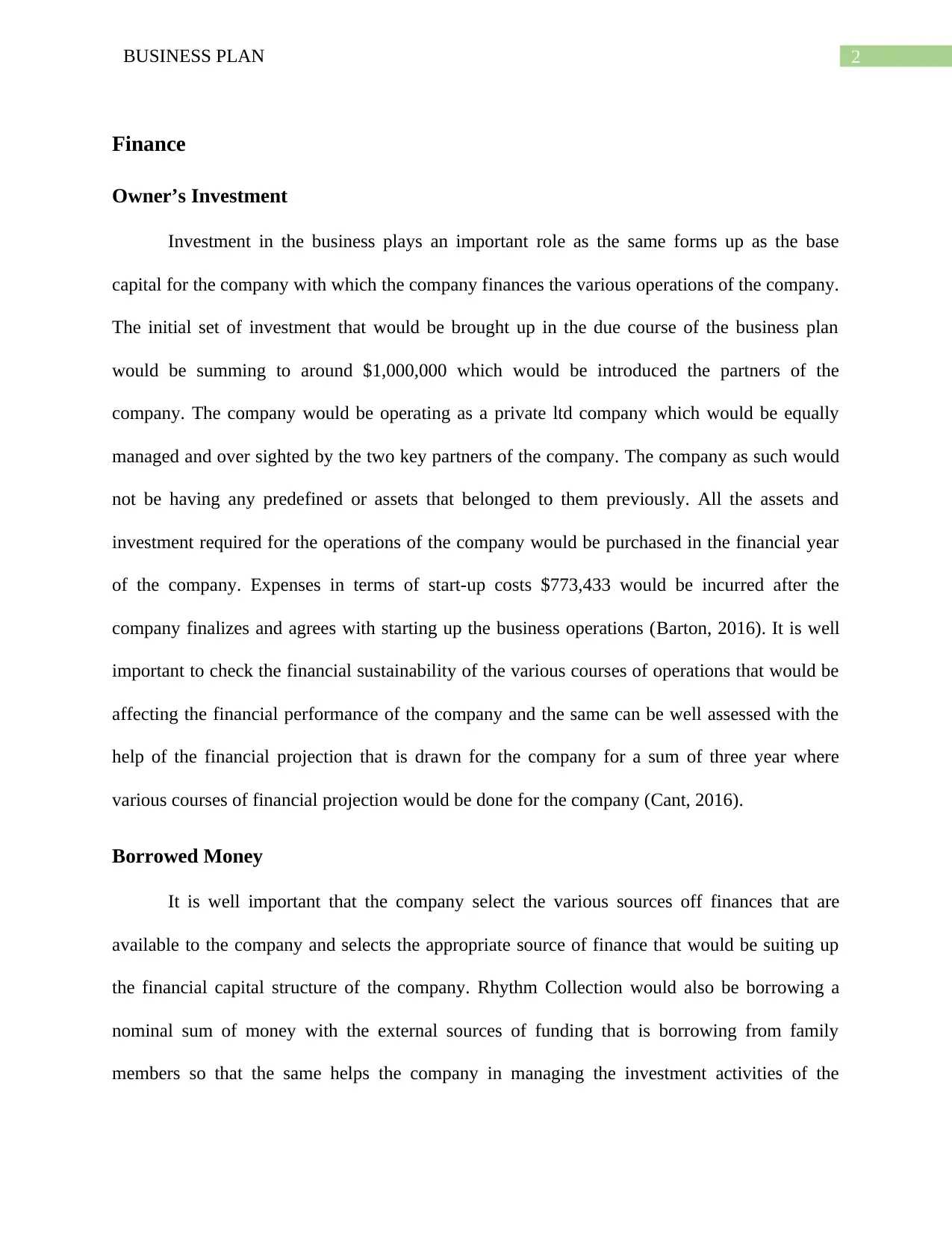
2BUSINESS PLAN
Finance
Owner’s Investment
Investment in the business plays an important role as the same forms up as the base
capital for the company with which the company finances the various operations of the company.
The initial set of investment that would be brought up in the due course of the business plan
would be summing to around $1,000,000 which would be introduced the partners of the
company. The company would be operating as a private ltd company which would be equally
managed and over sighted by the two key partners of the company. The company as such would
not be having any predefined or assets that belonged to them previously. All the assets and
investment required for the operations of the company would be purchased in the financial year
of the company. Expenses in terms of start-up costs $773,433 would be incurred after the
company finalizes and agrees with starting up the business operations (Barton, 2016). It is well
important to check the financial sustainability of the various courses of operations that would be
affecting the financial performance of the company and the same can be well assessed with the
help of the financial projection that is drawn for the company for a sum of three year where
various courses of financial projection would be done for the company (Cant, 2016).
Borrowed Money
It is well important that the company select the various sources off finances that are
available to the company and selects the appropriate source of finance that would be suiting up
the financial capital structure of the company. Rhythm Collection would also be borrowing a
nominal sum of money with the external sources of funding that is borrowing from family
members so that the same helps the company in managing the investment activities of the
Finance
Owner’s Investment
Investment in the business plays an important role as the same forms up as the base
capital for the company with which the company finances the various operations of the company.
The initial set of investment that would be brought up in the due course of the business plan
would be summing to around $1,000,000 which would be introduced the partners of the
company. The company would be operating as a private ltd company which would be equally
managed and over sighted by the two key partners of the company. The company as such would
not be having any predefined or assets that belonged to them previously. All the assets and
investment required for the operations of the company would be purchased in the financial year
of the company. Expenses in terms of start-up costs $773,433 would be incurred after the
company finalizes and agrees with starting up the business operations (Barton, 2016). It is well
important to check the financial sustainability of the various courses of operations that would be
affecting the financial performance of the company and the same can be well assessed with the
help of the financial projection that is drawn for the company for a sum of three year where
various courses of financial projection would be done for the company (Cant, 2016).
Borrowed Money
It is well important that the company select the various sources off finances that are
available to the company and selects the appropriate source of finance that would be suiting up
the financial capital structure of the company. Rhythm Collection would also be borrowing a
nominal sum of money with the external sources of funding that is borrowing from family
members so that the same helps the company in managing the investment activities of the
⊘ This is a preview!⊘
Do you want full access?
Subscribe today to unlock all pages.

Trusted by 1+ million students worldwide
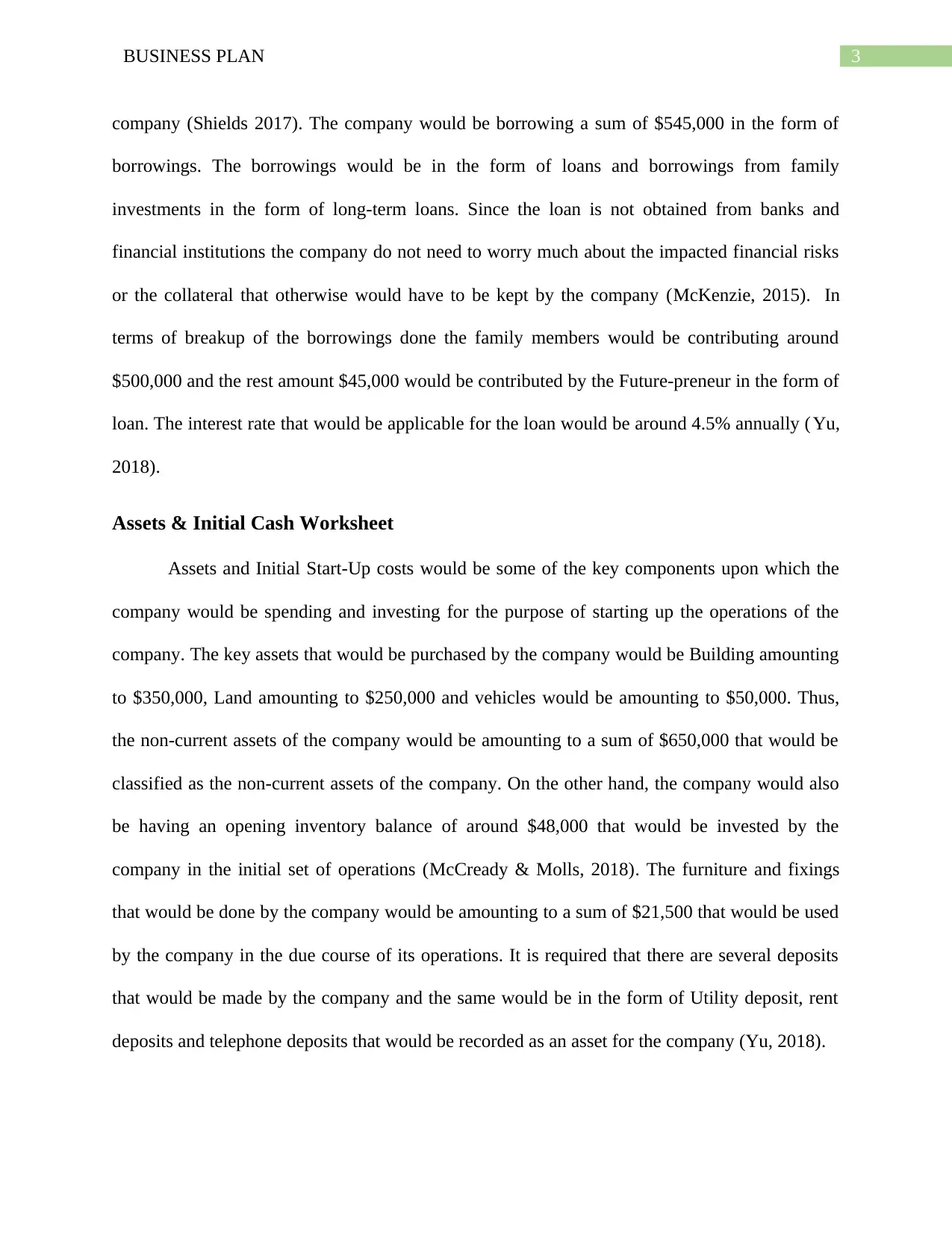
3BUSINESS PLAN
company (Shields 2017). The company would be borrowing a sum of $545,000 in the form of
borrowings. The borrowings would be in the form of loans and borrowings from family
investments in the form of long-term loans. Since the loan is not obtained from banks and
financial institutions the company do not need to worry much about the impacted financial risks
or the collateral that otherwise would have to be kept by the company (McKenzie, 2015). In
terms of breakup of the borrowings done the family members would be contributing around
$500,000 and the rest amount $45,000 would be contributed by the Future-preneur in the form of
loan. The interest rate that would be applicable for the loan would be around 4.5% annually (Yu,
2018).
Assets & Initial Cash Worksheet
Assets and Initial Start-Up costs would be some of the key components upon which the
company would be spending and investing for the purpose of starting up the operations of the
company. The key assets that would be purchased by the company would be Building amounting
to $350,000, Land amounting to $250,000 and vehicles would be amounting to $50,000. Thus,
the non-current assets of the company would be amounting to a sum of $650,000 that would be
classified as the non-current assets of the company. On the other hand, the company would also
be having an opening inventory balance of around $48,000 that would be invested by the
company in the initial set of operations (McCready & Molls, 2018). The furniture and fixings
that would be done by the company would be amounting to a sum of $21,500 that would be used
by the company in the due course of its operations. It is required that there are several deposits
that would be made by the company and the same would be in the form of Utility deposit, rent
deposits and telephone deposits that would be recorded as an asset for the company (Yu, 2018).
company (Shields 2017). The company would be borrowing a sum of $545,000 in the form of
borrowings. The borrowings would be in the form of loans and borrowings from family
investments in the form of long-term loans. Since the loan is not obtained from banks and
financial institutions the company do not need to worry much about the impacted financial risks
or the collateral that otherwise would have to be kept by the company (McKenzie, 2015). In
terms of breakup of the borrowings done the family members would be contributing around
$500,000 and the rest amount $45,000 would be contributed by the Future-preneur in the form of
loan. The interest rate that would be applicable for the loan would be around 4.5% annually (Yu,
2018).
Assets & Initial Cash Worksheet
Assets and Initial Start-Up costs would be some of the key components upon which the
company would be spending and investing for the purpose of starting up the operations of the
company. The key assets that would be purchased by the company would be Building amounting
to $350,000, Land amounting to $250,000 and vehicles would be amounting to $50,000. Thus,
the non-current assets of the company would be amounting to a sum of $650,000 that would be
classified as the non-current assets of the company. On the other hand, the company would also
be having an opening inventory balance of around $48,000 that would be invested by the
company in the initial set of operations (McCready & Molls, 2018). The furniture and fixings
that would be done by the company would be amounting to a sum of $21,500 that would be used
by the company in the due course of its operations. It is required that there are several deposits
that would be made by the company and the same would be in the form of Utility deposit, rent
deposits and telephone deposits that would be recorded as an asset for the company (Yu, 2018).
Paraphrase This Document
Need a fresh take? Get an instant paraphrase of this document with our AI Paraphraser
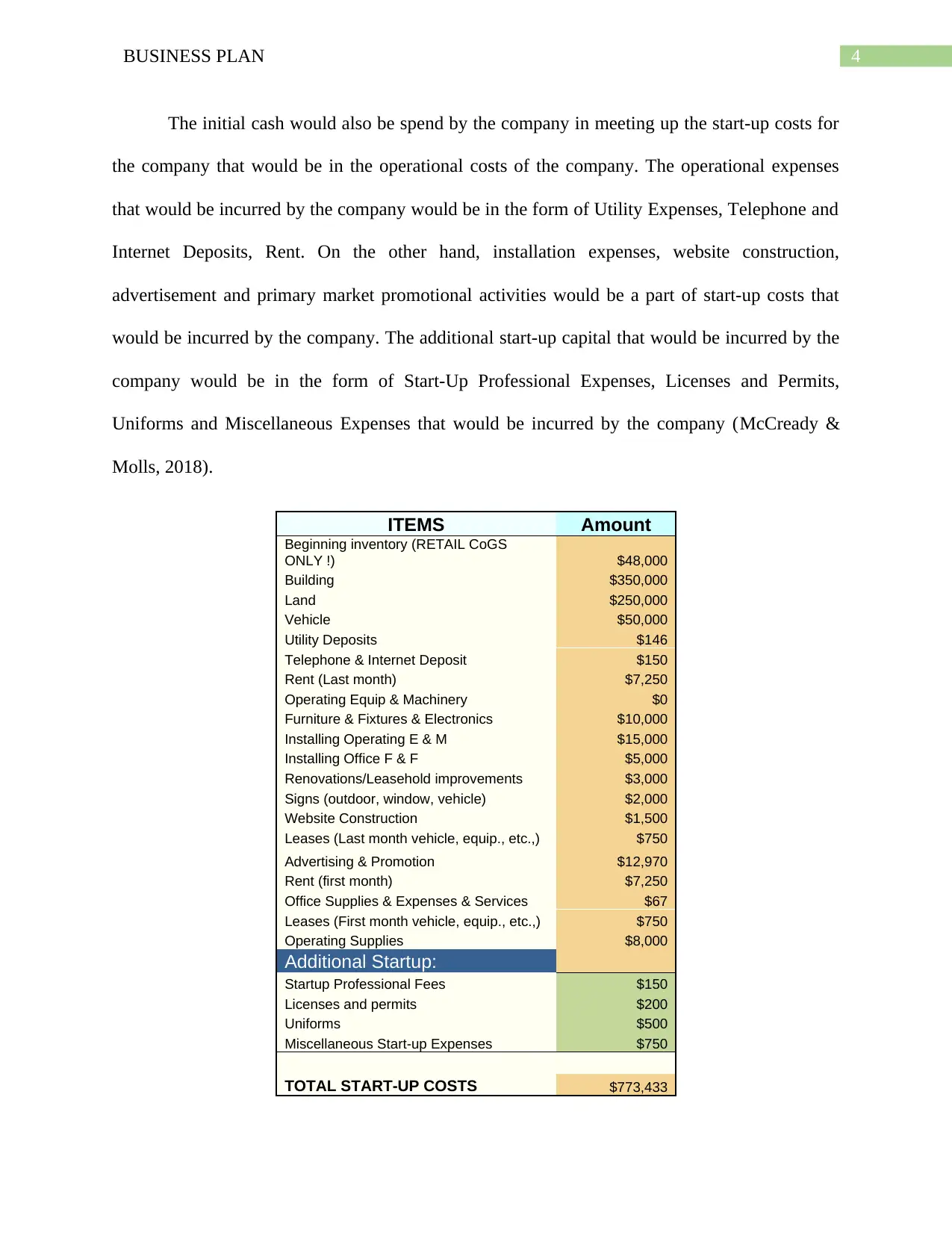
4BUSINESS PLAN
The initial cash would also be spend by the company in meeting up the start-up costs for
the company that would be in the operational costs of the company. The operational expenses
that would be incurred by the company would be in the form of Utility Expenses, Telephone and
Internet Deposits, Rent. On the other hand, installation expenses, website construction,
advertisement and primary market promotional activities would be a part of start-up costs that
would be incurred by the company. The additional start-up capital that would be incurred by the
company would be in the form of Start-Up Professional Expenses, Licenses and Permits,
Uniforms and Miscellaneous Expenses that would be incurred by the company (McCready &
Molls, 2018).
ITEMS Amount
Beginning inventory (RETAIL CoGS
ONLY !) $48,000
Building $350,000
Land $250,000
Vehicle $50,000
Utility Deposits $146
Telephone & Internet Deposit $150
Rent (Last month) $7,250
Operating Equip & Machinery $0
Furniture & Fixtures & Electronics $10,000
Installing Operating E & M $15,000
Installing Office F & F $5,000
Renovations/Leasehold improvements $3,000
Signs (outdoor, window, vehicle) $2,000
Website Construction $1,500
Leases (Last month vehicle, equip., etc.,) $750
Advertising & Promotion $12,970
Rent (first month) $7,250
Office Supplies & Expenses & Services $67
Leases (First month vehicle, equip., etc.,) $750
Operating Supplies $8,000
Additional Startup:
Startup Professional Fees $150
Licenses and permits $200
Uniforms $500
Miscellaneous Start-up Expenses $750
TOTAL START-UP COSTS $773,433
The initial cash would also be spend by the company in meeting up the start-up costs for
the company that would be in the operational costs of the company. The operational expenses
that would be incurred by the company would be in the form of Utility Expenses, Telephone and
Internet Deposits, Rent. On the other hand, installation expenses, website construction,
advertisement and primary market promotional activities would be a part of start-up costs that
would be incurred by the company. The additional start-up capital that would be incurred by the
company would be in the form of Start-Up Professional Expenses, Licenses and Permits,
Uniforms and Miscellaneous Expenses that would be incurred by the company (McCready &
Molls, 2018).
ITEMS Amount
Beginning inventory (RETAIL CoGS
ONLY !) $48,000
Building $350,000
Land $250,000
Vehicle $50,000
Utility Deposits $146
Telephone & Internet Deposit $150
Rent (Last month) $7,250
Operating Equip & Machinery $0
Furniture & Fixtures & Electronics $10,000
Installing Operating E & M $15,000
Installing Office F & F $5,000
Renovations/Leasehold improvements $3,000
Signs (outdoor, window, vehicle) $2,000
Website Construction $1,500
Leases (Last month vehicle, equip., etc.,) $750
Advertising & Promotion $12,970
Rent (first month) $7,250
Office Supplies & Expenses & Services $67
Leases (First month vehicle, equip., etc.,) $750
Operating Supplies $8,000
Additional Startup:
Startup Professional Fees $150
Licenses and permits $200
Uniforms $500
Miscellaneous Start-up Expenses $750
TOTAL START-UP COSTS $773,433
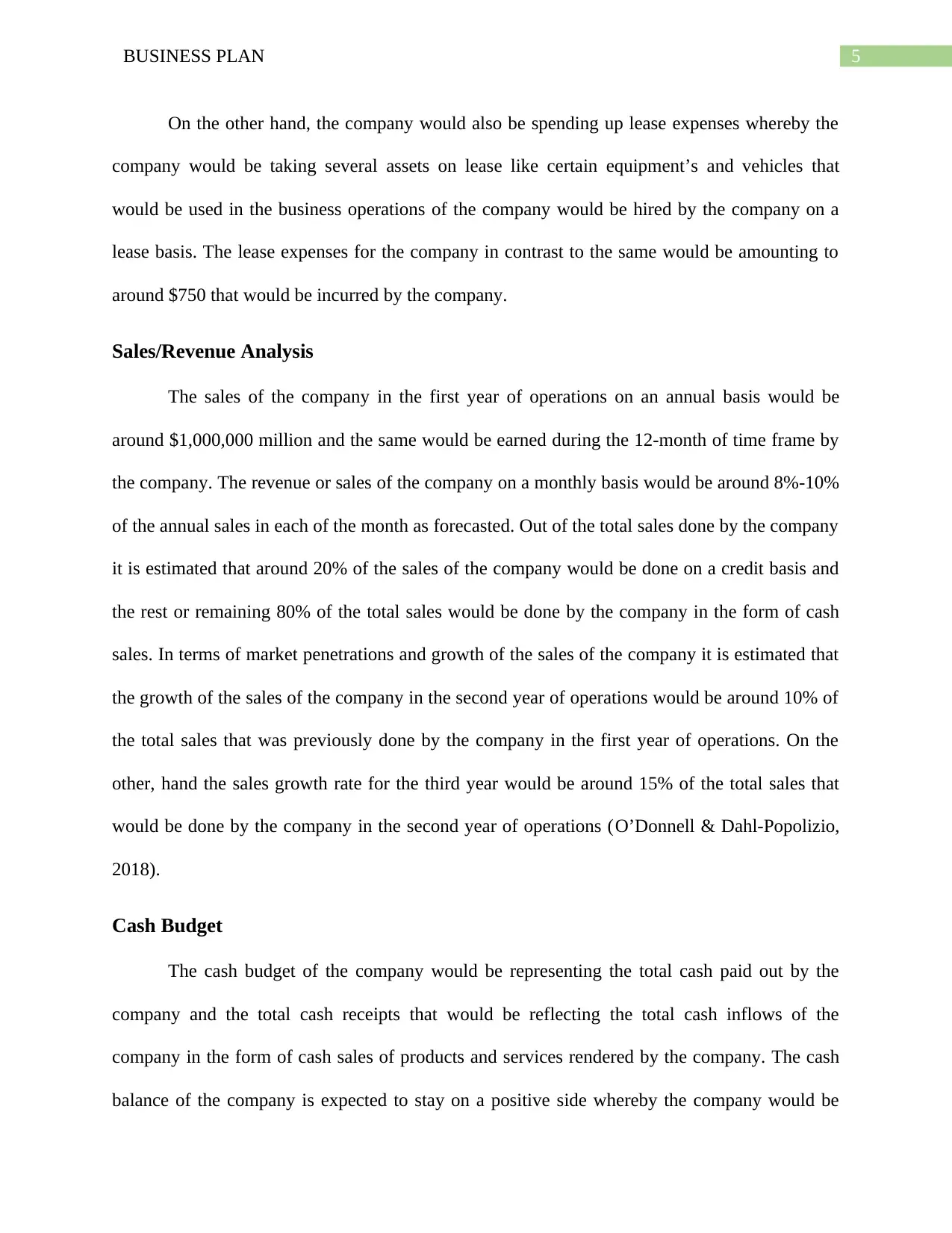
5BUSINESS PLAN
On the other hand, the company would also be spending up lease expenses whereby the
company would be taking several assets on lease like certain equipment’s and vehicles that
would be used in the business operations of the company would be hired by the company on a
lease basis. The lease expenses for the company in contrast to the same would be amounting to
around $750 that would be incurred by the company.
Sales/Revenue Analysis
The sales of the company in the first year of operations on an annual basis would be
around $1,000,000 million and the same would be earned during the 12-month of time frame by
the company. The revenue or sales of the company on a monthly basis would be around 8%-10%
of the annual sales in each of the month as forecasted. Out of the total sales done by the company
it is estimated that around 20% of the sales of the company would be done on a credit basis and
the rest or remaining 80% of the total sales would be done by the company in the form of cash
sales. In terms of market penetrations and growth of the sales of the company it is estimated that
the growth of the sales of the company in the second year of operations would be around 10% of
the total sales that was previously done by the company in the first year of operations. On the
other, hand the sales growth rate for the third year would be around 15% of the total sales that
would be done by the company in the second year of operations (O’Donnell & Dahl-Popolizio,
2018).
Cash Budget
The cash budget of the company would be representing the total cash paid out by the
company and the total cash receipts that would be reflecting the total cash inflows of the
company in the form of cash sales of products and services rendered by the company. The cash
balance of the company is expected to stay on a positive side whereby the company would be
On the other hand, the company would also be spending up lease expenses whereby the
company would be taking several assets on lease like certain equipment’s and vehicles that
would be used in the business operations of the company would be hired by the company on a
lease basis. The lease expenses for the company in contrast to the same would be amounting to
around $750 that would be incurred by the company.
Sales/Revenue Analysis
The sales of the company in the first year of operations on an annual basis would be
around $1,000,000 million and the same would be earned during the 12-month of time frame by
the company. The revenue or sales of the company on a monthly basis would be around 8%-10%
of the annual sales in each of the month as forecasted. Out of the total sales done by the company
it is estimated that around 20% of the sales of the company would be done on a credit basis and
the rest or remaining 80% of the total sales would be done by the company in the form of cash
sales. In terms of market penetrations and growth of the sales of the company it is estimated that
the growth of the sales of the company in the second year of operations would be around 10% of
the total sales that was previously done by the company in the first year of operations. On the
other, hand the sales growth rate for the third year would be around 15% of the total sales that
would be done by the company in the second year of operations (O’Donnell & Dahl-Popolizio,
2018).
Cash Budget
The cash budget of the company would be representing the total cash paid out by the
company and the total cash receipts that would be reflecting the total cash inflows of the
company in the form of cash sales of products and services rendered by the company. The cash
balance of the company is expected to stay on a positive side whereby the company would be
⊘ This is a preview!⊘
Do you want full access?
Subscribe today to unlock all pages.

Trusted by 1+ million students worldwide
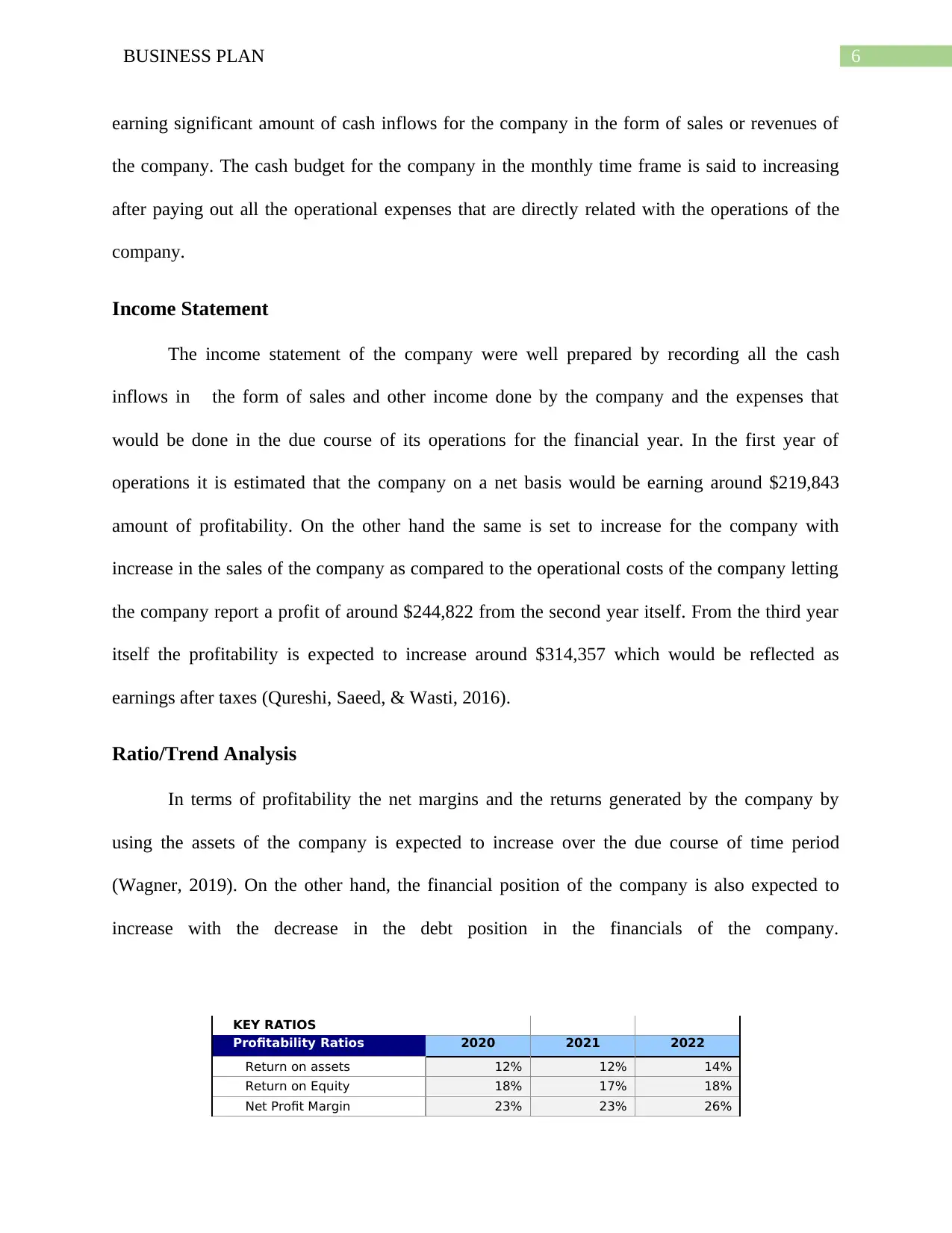
6BUSINESS PLAN
earning significant amount of cash inflows for the company in the form of sales or revenues of
the company. The cash budget for the company in the monthly time frame is said to increasing
after paying out all the operational expenses that are directly related with the operations of the
company.
Income Statement
The income statement of the company were well prepared by recording all the cash
inflows in the form of sales and other income done by the company and the expenses that
would be done in the due course of its operations for the financial year. In the first year of
operations it is estimated that the company on a net basis would be earning around $219,843
amount of profitability. On the other hand the same is set to increase for the company with
increase in the sales of the company as compared to the operational costs of the company letting
the company report a profit of around $244,822 from the second year itself. From the third year
itself the profitability is expected to increase around $314,357 which would be reflected as
earnings after taxes (Qureshi, Saeed, & Wasti, 2016).
Ratio/Trend Analysis
In terms of profitability the net margins and the returns generated by the company by
using the assets of the company is expected to increase over the due course of time period
(Wagner, 2019). On the other hand, the financial position of the company is also expected to
increase with the decrease in the debt position in the financials of the company.
KEY RATIOS
Profitability Ratios 2020 2021 2022
Return on assets 12% 12% 14%
Return on Equity 18% 17% 18%
Net Profit Margin 23% 23% 26%
earning significant amount of cash inflows for the company in the form of sales or revenues of
the company. The cash budget for the company in the monthly time frame is said to increasing
after paying out all the operational expenses that are directly related with the operations of the
company.
Income Statement
The income statement of the company were well prepared by recording all the cash
inflows in the form of sales and other income done by the company and the expenses that
would be done in the due course of its operations for the financial year. In the first year of
operations it is estimated that the company on a net basis would be earning around $219,843
amount of profitability. On the other hand the same is set to increase for the company with
increase in the sales of the company as compared to the operational costs of the company letting
the company report a profit of around $244,822 from the second year itself. From the third year
itself the profitability is expected to increase around $314,357 which would be reflected as
earnings after taxes (Qureshi, Saeed, & Wasti, 2016).
Ratio/Trend Analysis
In terms of profitability the net margins and the returns generated by the company by
using the assets of the company is expected to increase over the due course of time period
(Wagner, 2019). On the other hand, the financial position of the company is also expected to
increase with the decrease in the debt position in the financials of the company.
KEY RATIOS
Profitability Ratios 2020 2021 2022
Return on assets 12% 12% 14%
Return on Equity 18% 17% 18%
Net Profit Margin 23% 23% 26%
Paraphrase This Document
Need a fresh take? Get an instant paraphrase of this document with our AI Paraphraser
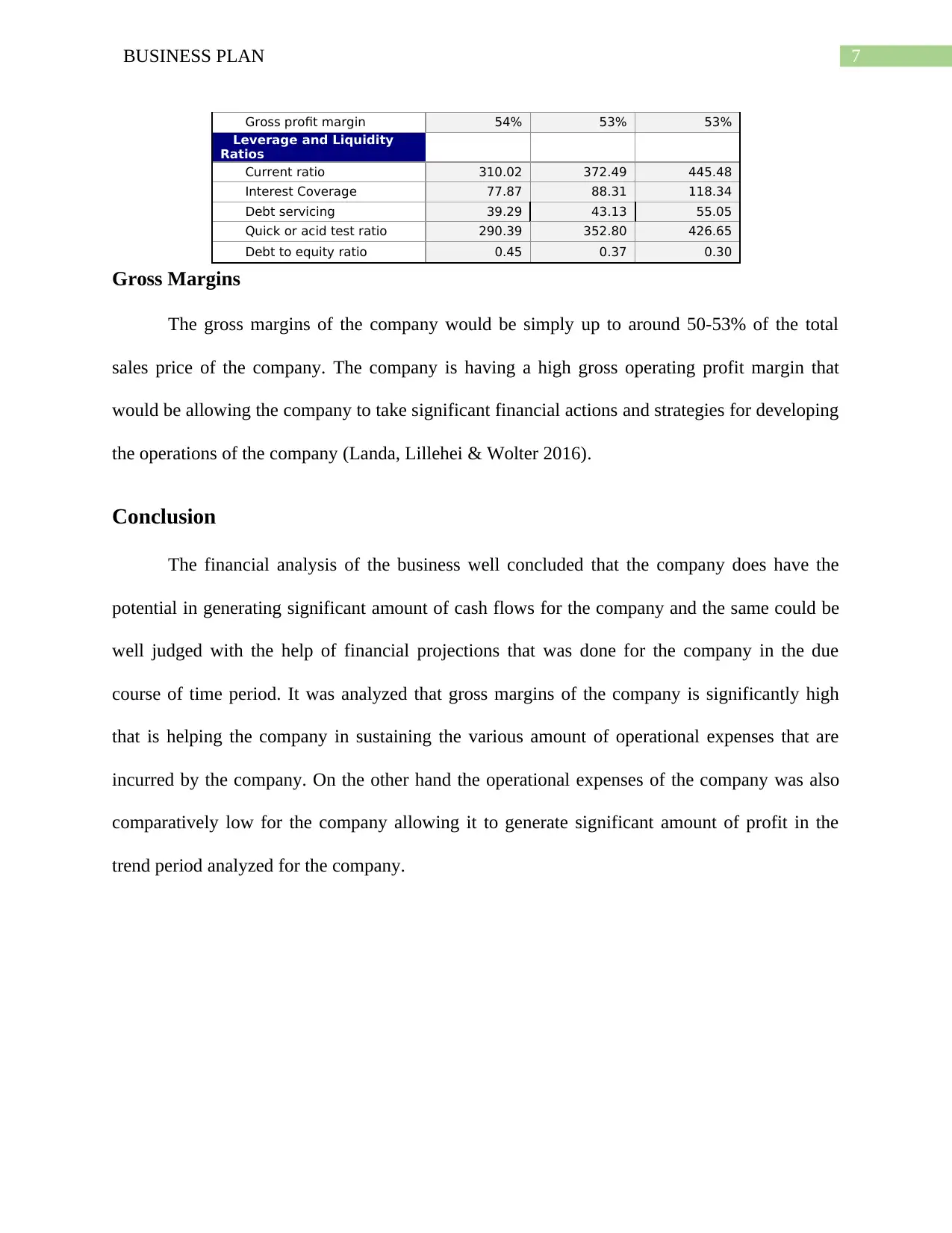
7BUSINESS PLAN
Gross profit margin 54% 53% 53%
Leverage and Liquidity
Ratios
Current ratio 310.02 372.49 445.48
Interest Coverage 77.87 88.31 118.34
Debt servicing 39.29 43.13 55.05
Quick or acid test ratio 290.39 352.80 426.65
Debt to equity ratio 0.45 0.37 0.30
Gross Margins
The gross margins of the company would be simply up to around 50-53% of the total
sales price of the company. The company is having a high gross operating profit margin that
would be allowing the company to take significant financial actions and strategies for developing
the operations of the company (Landa, Lillehei & Wolter 2016).
Conclusion
The financial analysis of the business well concluded that the company does have the
potential in generating significant amount of cash flows for the company and the same could be
well judged with the help of financial projections that was done for the company in the due
course of time period. It was analyzed that gross margins of the company is significantly high
that is helping the company in sustaining the various amount of operational expenses that are
incurred by the company. On the other hand the operational expenses of the company was also
comparatively low for the company allowing it to generate significant amount of profit in the
trend period analyzed for the company.
Gross profit margin 54% 53% 53%
Leverage and Liquidity
Ratios
Current ratio 310.02 372.49 445.48
Interest Coverage 77.87 88.31 118.34
Debt servicing 39.29 43.13 55.05
Quick or acid test ratio 290.39 352.80 426.65
Debt to equity ratio 0.45 0.37 0.30
Gross Margins
The gross margins of the company would be simply up to around 50-53% of the total
sales price of the company. The company is having a high gross operating profit margin that
would be allowing the company to take significant financial actions and strategies for developing
the operations of the company (Landa, Lillehei & Wolter 2016).
Conclusion
The financial analysis of the business well concluded that the company does have the
potential in generating significant amount of cash flows for the company and the same could be
well judged with the help of financial projections that was done for the company in the due
course of time period. It was analyzed that gross margins of the company is significantly high
that is helping the company in sustaining the various amount of operational expenses that are
incurred by the company. On the other hand the operational expenses of the company was also
comparatively low for the company allowing it to generate significant amount of profit in the
trend period analyzed for the company.
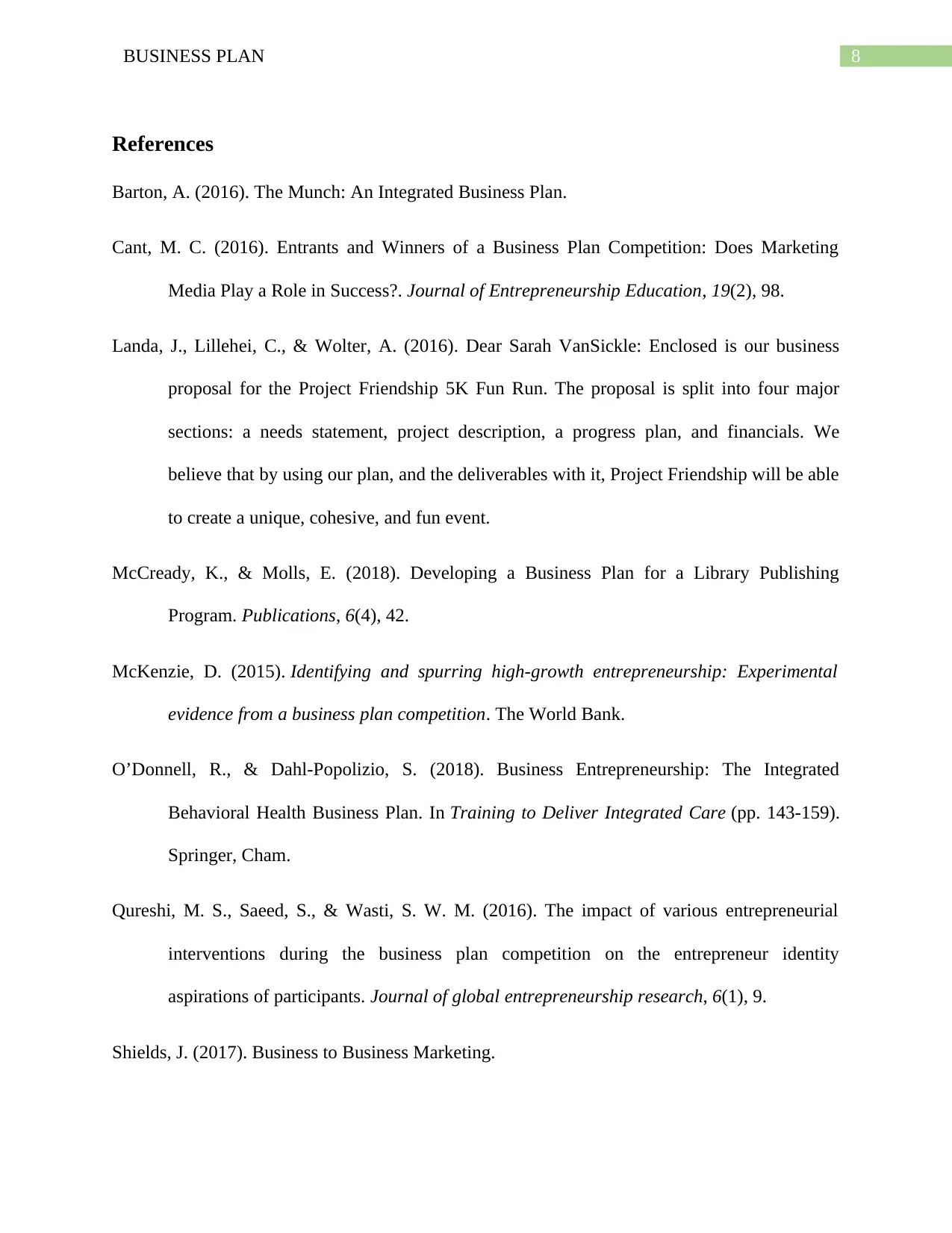
8BUSINESS PLAN
References
Barton, A. (2016). The Munch: An Integrated Business Plan.
Cant, M. C. (2016). Entrants and Winners of a Business Plan Competition: Does Marketing
Media Play a Role in Success?. Journal of Entrepreneurship Education, 19(2), 98.
Landa, J., Lillehei, C., & Wolter, A. (2016). Dear Sarah VanSickle: Enclosed is our business
proposal for the Project Friendship 5K Fun Run. The proposal is split into four major
sections: a needs statement, project description, a progress plan, and financials. We
believe that by using our plan, and the deliverables with it, Project Friendship will be able
to create a unique, cohesive, and fun event.
McCready, K., & Molls, E. (2018). Developing a Business Plan for a Library Publishing
Program. Publications, 6(4), 42.
McKenzie, D. (2015). Identifying and spurring high-growth entrepreneurship: Experimental
evidence from a business plan competition. The World Bank.
O’Donnell, R., & Dahl-Popolizio, S. (2018). Business Entrepreneurship: The Integrated
Behavioral Health Business Plan. In Training to Deliver Integrated Care (pp. 143-159).
Springer, Cham.
Qureshi, M. S., Saeed, S., & Wasti, S. W. M. (2016). The impact of various entrepreneurial
interventions during the business plan competition on the entrepreneur identity
aspirations of participants. Journal of global entrepreneurship research, 6(1), 9.
Shields, J. (2017). Business to Business Marketing.
References
Barton, A. (2016). The Munch: An Integrated Business Plan.
Cant, M. C. (2016). Entrants and Winners of a Business Plan Competition: Does Marketing
Media Play a Role in Success?. Journal of Entrepreneurship Education, 19(2), 98.
Landa, J., Lillehei, C., & Wolter, A. (2016). Dear Sarah VanSickle: Enclosed is our business
proposal for the Project Friendship 5K Fun Run. The proposal is split into four major
sections: a needs statement, project description, a progress plan, and financials. We
believe that by using our plan, and the deliverables with it, Project Friendship will be able
to create a unique, cohesive, and fun event.
McCready, K., & Molls, E. (2018). Developing a Business Plan for a Library Publishing
Program. Publications, 6(4), 42.
McKenzie, D. (2015). Identifying and spurring high-growth entrepreneurship: Experimental
evidence from a business plan competition. The World Bank.
O’Donnell, R., & Dahl-Popolizio, S. (2018). Business Entrepreneurship: The Integrated
Behavioral Health Business Plan. In Training to Deliver Integrated Care (pp. 143-159).
Springer, Cham.
Qureshi, M. S., Saeed, S., & Wasti, S. W. M. (2016). The impact of various entrepreneurial
interventions during the business plan competition on the entrepreneur identity
aspirations of participants. Journal of global entrepreneurship research, 6(1), 9.
Shields, J. (2017). Business to Business Marketing.
⊘ This is a preview!⊘
Do you want full access?
Subscribe today to unlock all pages.

Trusted by 1+ million students worldwide
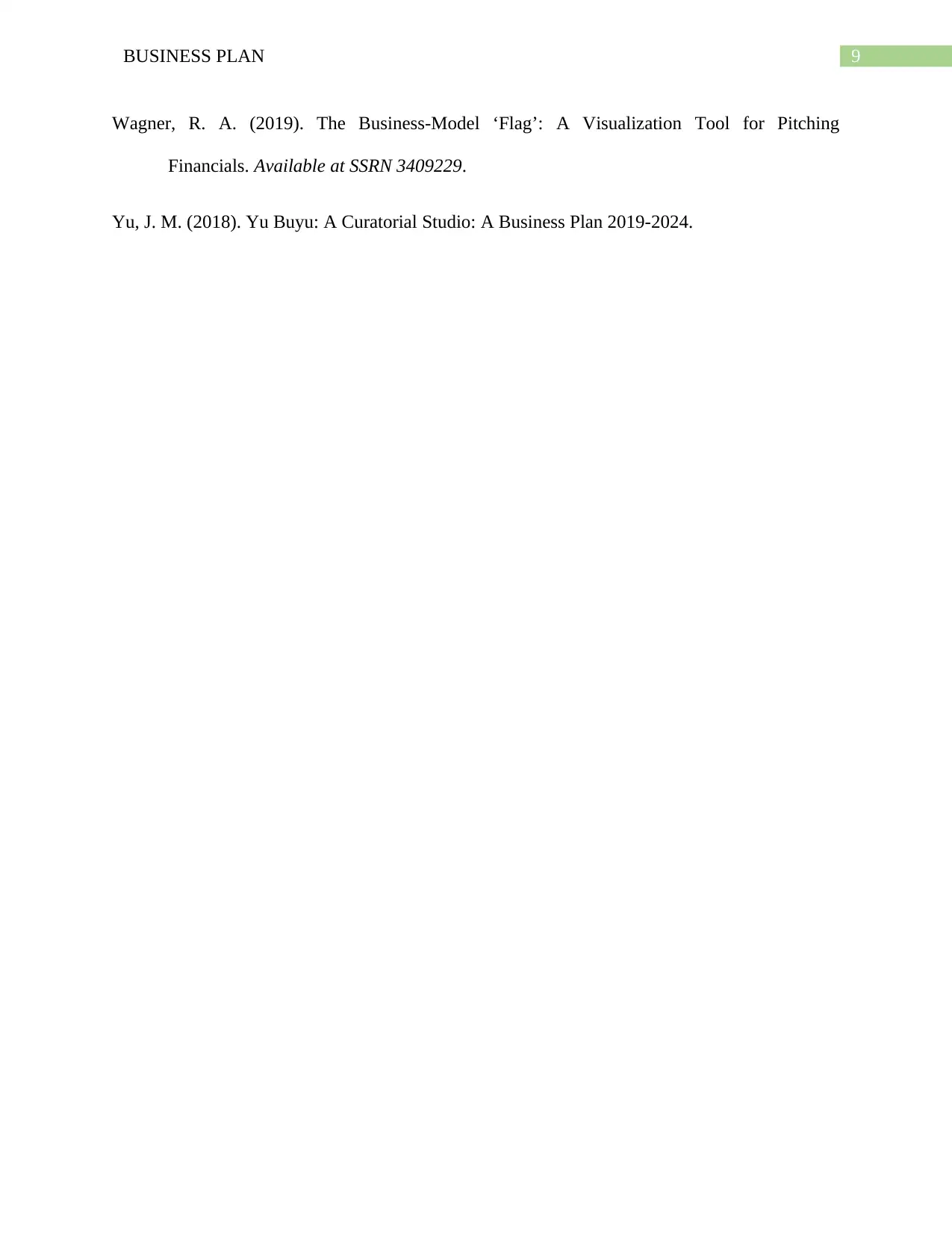
9BUSINESS PLAN
Wagner, R. A. (2019). The Business-Model ‘Flag’: A Visualization Tool for Pitching
Financials. Available at SSRN 3409229.
Yu, J. M. (2018). Yu Buyu: A Curatorial Studio: A Business Plan 2019-2024.
Wagner, R. A. (2019). The Business-Model ‘Flag’: A Visualization Tool for Pitching
Financials. Available at SSRN 3409229.
Yu, J. M. (2018). Yu Buyu: A Curatorial Studio: A Business Plan 2019-2024.
1 out of 10
Related Documents
Your All-in-One AI-Powered Toolkit for Academic Success.
+13062052269
info@desklib.com
Available 24*7 on WhatsApp / Email
![[object Object]](/_next/static/media/star-bottom.7253800d.svg)
Unlock your academic potential
Copyright © 2020–2025 A2Z Services. All Rights Reserved. Developed and managed by ZUCOL.





